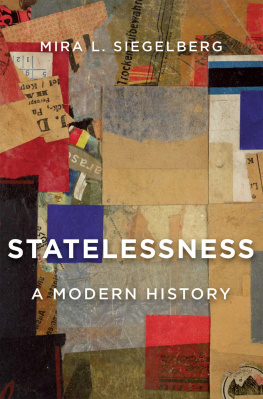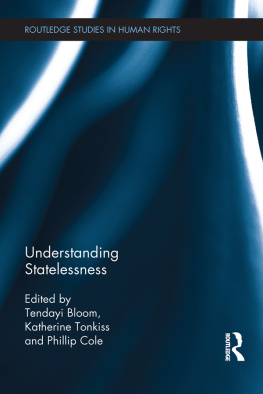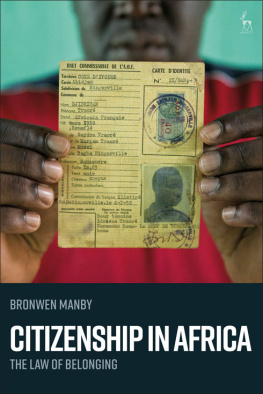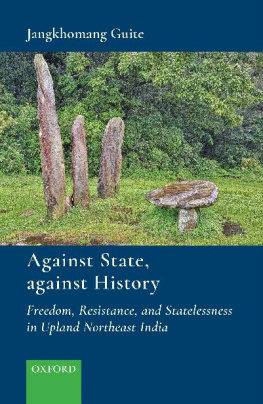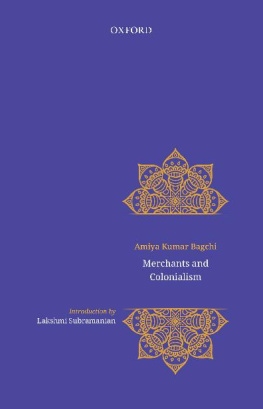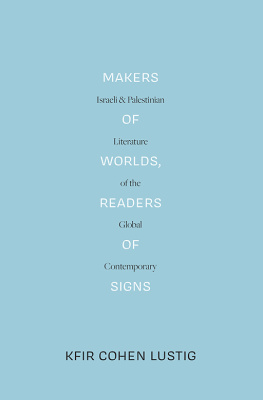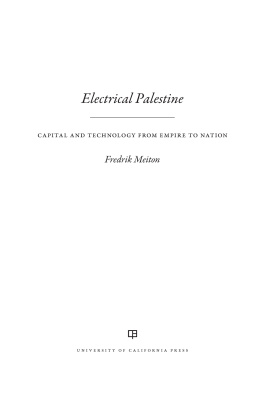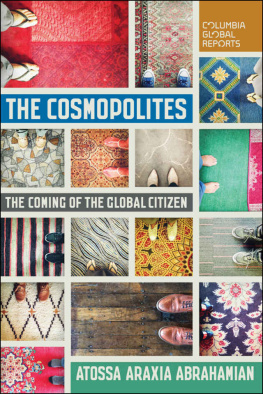Siegelberg - Statelessness
Here you can read online Siegelberg - Statelessness full text of the book (entire story) in english for free. Download pdf and epub, get meaning, cover and reviews about this ebook. year: 2020, publisher: Harvard Univ Pr, genre: Politics. Description of the work, (preface) as well as reviews are available. Best literature library LitArk.com created for fans of good reading and offers a wide selection of genres:
Romance novel
Science fiction
Adventure
Detective
Science
History
Home and family
Prose
Art
Politics
Computer
Non-fiction
Religion
Business
Children
Humor
Choose a favorite category and find really read worthwhile books. Enjoy immersion in the world of imagination, feel the emotions of the characters or learn something new for yourself, make an fascinating discovery.
- Book:Statelessness
- Author:
- Publisher:Harvard Univ Pr
- Genre:
- Year:2020
- Rating:5 / 5
- Favourites:Add to favourites
- Your mark:
- 100
- 1
- 2
- 3
- 4
- 5
Statelessness: summary, description and annotation
We offer to read an annotation, description, summary or preface (depends on what the author of the book "Statelessness" wrote himself). If you haven't found the necessary information about the book — write in the comments, we will try to find it.
Statelessness — read online for free the complete book (whole text) full work
Below is the text of the book, divided by pages. System saving the place of the last page read, allows you to conveniently read the book "Statelessness" online for free, without having to search again every time where you left off. Put a bookmark, and you can go to the page where you finished reading at any time.
Font size:
Interval:
Bookmark:

STATELESSNESS
Copyright 2020 by the President and Fellows of Harvard College
All rights reserved
Printed in the United States of America
First printing
Interior design by Dean Bornstein
Jacket design: Jill Breitbarth
Jacket art: Mz 26,53 Telef., 1926. German: Mz 26,53 Fernspr. collage by Kurt Schwitters, private collection/Bridgeman Images, 2020 Artist Rights Society (ARS), New York/VG Bild-Kunst, Bonn
9780674976313 (cloth)
9780674240513 (EPUB)
9780674240520 (MOBI)
9780674240490 (PDF)
Library of Congress Cataloging-in-Publication Data
Names: Siegelberg, Mira L., 1983- author.
Title: Statelessness : a modern history / Mira L. Siegelberg.
Identifiers: LCCN 2019055654 | ISBN 9780674976313 (cloth)
Subjects: LCSH: Statelessness. | Stateless persons.
Classification: LCC K7128.S7 .S54 2020 | DDC 342.08/3dc23
LC record available at https://lccn.loc.gov/2019055654
For my parents, Florence and Alan Siegelberg, with all my love
I N A 1930 LETTER , the German artist Kurt Schwitters described the impetus for his Merzbilder, a style of painted collage that he had invented at the end of the First World War. Everything was wrecked anyway, he explained, and new things had to be made from the fragments. Schwitterss collages from the 1920s decontextualize the detritus of modern life, turning everyday trashold tickets, buttons, train schedules, bus routes, bits of newspaperinto grid-like compositions of abstract shape, color, and line. Re-formed into something else altogether, the reconfigured fragments convey, in certain moments, rigid lines separating distinct territories, while at other moments they show how the territories overlap and blur together.
Like many of the individuals discussed in this book, Schwitters became a stateless person as a result of the political upheavals of the twentieth century. In Schwitterss case this meant that he lost the security of his German citizenship when he fled Nazi Germany in 1937, eventually finding refuge in West London, though not before facing internment as an enemy national on the Isle of Man. Schwitterss Merz paintings from the 1920s are an apt place to begin this study of statelessnessnot primarily for reasons of biography but rather because his works from this period powerfully evoke the way in which the First World War unsettled the basic concepts that defined political reality. The map of the world, it seemed, would need to be remade entirely. The Merz collages date from the decade reconstructed in the first half of this study, an era of imperial breakdown and state creation following World War I, when mass numbers of people defined by their exclusion from any political community entered international politics and became the object of intensive debate about the foundations of political order.
Intuitively, the concept of statelessness relates to a broad set of issues surrounding the political organization of humanity. The term brings to mind contentious conflicts over when and how communities that seek to govern themselves gain recognition as independent and autonomous agents. It equally suggests the plight of the more than seventy million people who are currently forcibly displaced around the world. When applied to the growing numbers of those whose countries are sinking beneath the waves of the Pacific Ocean, statelessness exposes the limits of how statehood and political membership have been defined in international law, as climate change has begun to reshape the territorial basis of sovereignty. In short, statelessness is a concept that encompasses some of the most destabilizing developments of modern politics.
Despite the explosive, and various, political implications of the concept in its broadest sense, it is the international agreements created in the aftermath of the Second World War that define what it means to be a stateless person and set the basic rules for living outside the boundaries of states and seeking entry into them. These agreements demarcate limited exceptions to the general presumption that states possess a fundamental right to determine who counts as a member and to exercise control over who crosses their borders.
Until recently, legal statelessness has been treated as a comparatively marginal issue, gaining prominence only in the past few years among legal scholars and political theorists and within humanitarian agencies. Yet what now seems like a small part of the broader crisis of mass homelessness and global migration has a history that clarifies how expectations about the legitimate boundaries of political life were forged in the first place. Despite the fact that not all countries have signed on to such agreements, and not all signatories abide by their provisions, the conventions that set the terms of international inclusion and exclusion are one of the critical ways that the world was carved up into its constituent political parts.
The central aim of this book is, therefore, to reconstruct and clarify the arguments that shaped the eventual stabilization of shared understandings of citizenship and noncitizenship in the decades following the Second World War. I explore the origins of the legal frameworks that govern the relationship between states and their nationals, and the roles of ideas, arguments, and ideological justification in their creation. To do so, this book investigates how the problem of statelessness informed theories of rights, sovereignty, international legal order, and cosmopolitan justice, theories developed when the conceptual and political contours of the modern interstate order were being worked out, against the background of some of the most violent and catastrophic events in modern history.
The emergence of the modern legal category of statelessness has most often been portrayed by historians as a consequence of the triumph of nationalism in the twentieth century and the collapse of more fluid forms of political identification and protection characteristic of expansive empires. According to these narratives, in the name of national cohesion, and often in defense of democracy and popular sovereignty, national states claimed the right to define their communities in more exclusive ways, while the rise of fascism and violence against minority groups produced unprecedented flows of refugees by the mid-twentieth century. The nearly forty-year crisis of mass displacement and political homelessness precipitated by the two world wars and the end of empire culminated, on this account, in the creation of the modern international legal frameworks that define those excluded in one way or another from the security of citizenship. These histories in turn tend to trace the rise of modern regimes of rights and governance, from incipient efforts at the League of Nations to provide legal protection to select groups of refugees, to the creation of more universal legal frameworks at the United Nations, its postwar successor. They describe exclusion from the privileges of citizenship as the dark side of democracy, sovereignty, and national self-determinationdeficiencies that international organizations and international law have tried to address by legalizing the rights of individuals who do not benefit from the protection of states.
This book tells a different story, one that is more responsive to the fact that the conceptual, legal, and political architecture that defines modern international order has in recent years emerged as the urgent object of historical and theoretical investigation. Historians have shown that it was not until the 1960s that alternative forms of political organizationcity-states, princedoms, federations, protectorates, dominions, extraterritorial enclaves, and complex politiesgave way to a more homogenized political map of the world. Both historians and political theorists have likewise begun to recover how ideas of collective self-determination, sovereignty, political representation, and democratic self-rule were conceptualized in a range of ways, often compatible with greater integration with imperial polities. The retrieval of such alternative visions of collective political life generates new pressure to explain how the modern state became the dominant form of political organization in the period after the Second World War. It also raises new questions about the role played by international law and international organizations in the formation of the modern international order, an order that is premised on the formal equality of states but which contains persistent hierarchies and asymmetries of power and privilege. In other words, once we appreciate that the nation state as the sole postimperial claimant to international legitimacy is a more recent phenomenon than previously understood, we have reason to investigate how the international categories defining noncitizenship contributed to the formation and legitimation of the boundaries of interstate order.
Font size:
Interval:
Bookmark:
Similar books «Statelessness»
Look at similar books to Statelessness. We have selected literature similar in name and meaning in the hope of providing readers with more options to find new, interesting, not yet read works.
Discussion, reviews of the book Statelessness and just readers' own opinions. Leave your comments, write what you think about the work, its meaning or the main characters. Specify what exactly you liked and what you didn't like, and why you think so.

